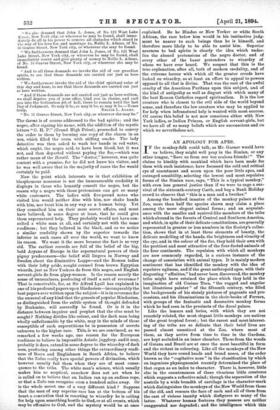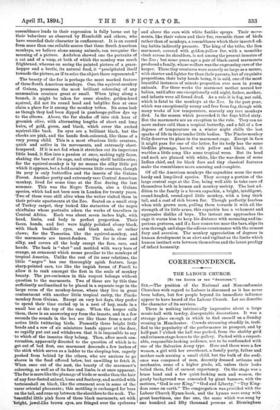AN APOLOGY FOR APES.
IF the monkey-folk could talk, as Mr. Garner would have us believe, they might well pray in the Simian, or any other tongue, "Save us from our too zealous friends ! " The claims to kinship with mankind which have been made for them with such insistence, have focussed the cold and critical eye of resentment and scorn upon the poor little apes, and outraged sensibility, selecting the lowest and most repulsive forms of the Simian race, says, "This is a typical monkey," with even less general justice than if we were to cage a sur- vival of the sixteenth-century Carib, and beg a Bank Holiday crowd to observe that "this is a man and a brother."
Among the hundred inmates of the monkey palace at the Zoo, more than half the species shown may claim a place among the more elegant animal forms ; and an acquaint- ance with the smaller and squirrel-like members of the tribe which abound in the forests of Central and Southern America, and which, in spite of their delicate constitutions, are generally represented in greater or less numbers in the Society's collec- tion, shows that in at least three elements of beauty, the delicate modelling of the hands, the brightness and vivacity of the eye, and in the colour of the fur, they hold their own with the prettiest and most attractive of the four-footed animals of the four continents. The repulsion with which all monkeys are now commonly regarded, is a curious instance of the change of association with animal types. It is mainly modern sentiment that has identified the monkey with the idea of repulsive ugliness, and if the great anthropoid apes, with their disgusting "affinities," had never been discovered, the monkey tribe might have retained the place which they held in the imagination of old Cosimo Tura, "the rugged and angular but illustrious painter" of the fifteenth century, who filled the backgrounds of his stately pictures of pageants and pro- cessions, and his illuminations in the choir-books of Ferrara, with groups of the fantastic and decorative monkey forms which he had seen in the precincts of the ducal palace.
Like the lemurs and lories, with which they are not remotely related, the most elegant little monkeys are natives of the great tropical forest ; but the rarest and most interest- ing of the tribe are so delicate that their brief lives are passed almost unnoticed at the Zoo, where most of them, as they arrive from time to time in the Gardens, are kept secluded in an inner chamber. Those from the woods of Guiana and Brazil are at once the most beautiful in form and the richest in colouring. Like all the monkeys of the New World they have round heads and broad noses, of the order known as the "cogitative nose" in the classification by which an ingenious physiognomist recently determined the place of that organ as an index to character. There is, however, little else in the countenances of these vivacious little creatures which suggests a reflective mind; though the separation of the nostrils by a wide breadth of cartilage is the character-mark which distinguishes the monkeys of the New World from those of the old, and rescues the face of each and all of them from the cast of vicious inanity which disfigures so many of the latter. Whatever human features they possess are neither exaggerated nor degraded; and the intelligence which this resemblance lends to their expression is fully borne out by their behaviour as observed by Humboldt and others, who have recorded their character in confinement. It is on record from more than one reliable source that these South American monkeys, we believe alone among animals, can recognise the meaning of a picture. Audubon showed one the portraits of a, cat and of a wasp, at both of which the monkey was much frightened, whereas on seeing the painted picture of a grass- hopper and a beetle, its natural food, it "precipitated itself towards the picture, as if to seize the object there represented."
The beauty of the far is perhaps the most marked feature of these South American monkeys. One, the squirrel-monkey of Guiana, possesses the most brilliant colouring of any mammalian creature great or small. When lying along a branch, it might be taken for some slender, golden-hued squirrel, did not its round head and babylike face at once claim a place for it among the monkey tribes. Its arms look as though they had been dipped in gatnbooge-yellow dye up to the elbows. Above, the fur shades off into rich hues of greenish olive, with alternating lengths of short and long hairs, of gold, green, and black, which cover the arched squirrel-like back. Its eyes are a brilliant black, but the cheeks are pink, and the hands flesh-coloured, like those of a very young child. This is a most vrvaciotts little creature, quick and active in its movements, and extremely short- tempered. If it is not fed when it stretches out its imperious little hand, it flies into a passion at once, making ugly faces, shaking the bars of its cage, and uttering shrill batlike cries; for the squirrel-monkey is by no means the silky little pet which it appears, but a bold carnivorous little creature, though its prey is only butterflies and the insects of the Guiana Forest. Another pretty and extremely rare Central American monkey, lived for some time at the Zoo during the last summer. This was the Negro Tamarin, also a Guiana species, which had not been seen in London for twenty years. Two of these were still alive when the writer visited them in their private apartments at the Zoo. Seated on a small strip ,of Turkey carpet, they looked like statuettes of the negro chieftains whose portraits adorn the works of travellers in 'Central Africa. Each was about seven inches high, with head, limbs, and body in perfect proportion. Their faces, hands, and feet were highly polished ebony. black, with black beadlike eyes, and black nails, or rather 'claws; for the Tamarins, like the squirrel-monkey, and 1,-he marmosets are insect-feeders. The fur is close and silky, and covers all the body except the face, ears, and hands. The back is "shot" and mottled with wavy bars of orange, an ornament which seems peculiar to the monkeys of tropical America. Unlike the rest of its near relations, the little " negro " has one thoroughly apish feature, large sharp-pointed ears, too like the impish forms of Fuseli to -allow it to rank amongst the first in the scale of monkey beauty. The pre-eminence in this respect belongs without question to the marmosets. Two of these are by this time -sufficiently a,cclimatised to be placed in a separate cage in the 'large room of the monkey-house, where they live in great -contentment with another little tropical rarity, the Pinche monkey from Guiana. Except on very hot days, they prefer -to spend their time curled up in a nest of hay, made in a small box at the top of the cage. When the keeper calls -them, there is an answering cry from the inmate, and in a few -seconds the sounds in the box are like those from a nest of active little twittering birds. Presently three bright little 'heads and a row of six miniature hands appear at the door, so rapidly put out and withdrawn that it is impossible to say -to which of the inmates they belong. Then, after much con- versation, apparently directed to the question of which is to get out of bed first, one marmoset descends a few inches of -the stick which serves as a ladder to the sleeping-box, eagerly pushed from behind by the others, who are anxious to go shares in the food offered below, but unwilling to fetch it. When once out of the nest, the beauty of the marmoset's colouring, as well as of its face and limbs, is at once apparent. The fur is more like the plumage of birds or moths than the hair of any four-footed animal, loose and feathery, and mottled with tortoiseshell on black, like the ornament seen in some of the rarer oriental pheasants ; this mottling is exchanged for bars on the tail, and runs up between the shoulders to the neck. The 'beautiful little pink faces of these black marmosets, set with 'bright, jewel-like brown eyes, are fringed over the eyebrows and above the ears with white fanlike sprays. Their move- ments, like their voices and their fur, resemble those of birds rather than of monkeys, a resemblance which their insect-ft ed- ing habits indirectly promote. The king of the tribe, the lion marmoset, covered with golden-yellow fur, with a manelike cloak across its shoulders, is not among the present inmates of the Zoo ; but some years ago a pair of black-eared marmosets produced a family, whose welfare was the engrossing care of the keeper. These tiny creatures were scarcely so large as a mouse, with shorter and lighter fur than their parents, but of exquisite proportions, their baby hands being, it is said, one of the most beautiful instances of minute proportion ever seen in young animals. For three weeks the marmoset mother nursed her babies, until after one exceptionally cold night, father, mother, and infants were all found dead. As a rule it is fog, not cold, which is fatal to the monkeys at the Zoo. In the past year, which was exceptionally sunny and free from fog, though with many weeks of low temperature, scarcely any rare monkeys died. In the season which proceeded it the fogs killed sixty. But the marmosets are an exception to the rule. They can no more endure cold than a tropical butterfly, and a fall of a few degrees of temperature on a winter night chills the last sparks of life in their tender little bodies. The Pinche monkey fully deserves its place in the marmoset cage. Except in face it might pass for one of the latter, for its body has the same birdlike plumage, barred with yellow and black, and it warbles a little song like some tropical wren. But its head and neck are plumed with white, like the war-dress of some Indian chief, and its black face and tiny classical features make the resemblance more amusing and complete.
Of all the American monkeys the capuchins seem the most hardy and long-lived species. They occupy a portion of the large central cage at the Zoo, being well able to take care of themselves both in human and monkey society. The last ad- dition to the family is a brown capuchin, a bright, intelligent, round-headed, round-eyed little monkey, with a long thick tail, and a coat of rich brown fur. Though perfectly fearless when with grown men, pulling them towards it with all the strength of its little arms, this capuchin has a vehement and aggressive dislike of boys. The instant one approaches the cage it warns him to keep his distance with menacing and im- perious gestures, and if a face comes too near the bars, slips its arm through and slaps the odious countenance with the utmost fury and aversion. The monkey appreciation of degrees in human development is as alert and vigilant as the limits which human instinct sets between themselves and the latest, prodigy of infant humanity.



































 Previous page
Previous page